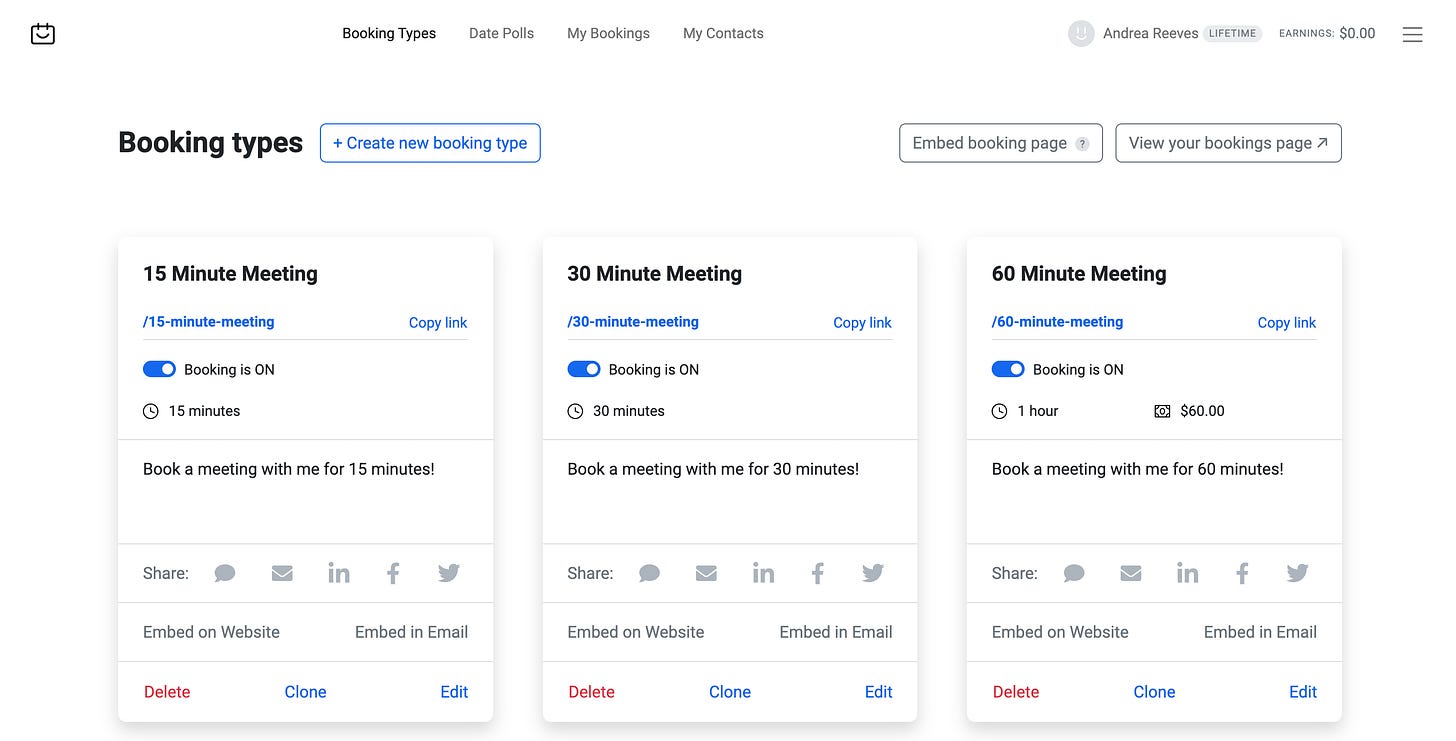When Time Blocking Doesn't Work...
A different approach to task planning + free Notion template
❣️ Important, Money-Saving Announcement
Before we get into it, I gotta tell you about TidyCal. Not only is this not sponsored, I also get zero doll hairs or affiliate credit for promoting this platform, AND I paid for my own subscription.
I used to pay for Calendly because IYKYK1 but came across a $29 lifetime deal for TidyCal (thank you to my Instagram algorithm, which feeds me nothing but cat videos and productivity software ads). As a solo entrepreneur, the Calendly bill was never my favorite to pay — but up until now, I hadn’t found a scheduling alternative that quite measured up (sorry, Acuity…with your clunky ass).
The interface is as clean and user-friendly as Calendly’s without it costing me upwards of $120+ a year. You can create as many booking types as you want, use meeting polls for group scheduling, and you can collect a fee for the booking types of your choice using their Stripe integration.
It also has one-click migration from Calendly, making switching platforms abreeze.com
Sooooooo, what’re you waiting for? Check out TidyCal and save yourself some monies.
⏰ Time blocking doesn’t work for me
One of the reasons I named this newsletter Rebellious Systems is because I hate being told what to do and when to do it.
Because I’m hyper sensitive to my own energy levels and moods throughout the day, finding flexible and motivating systems that work for me can be challenging. More specifically, I feel very resistant to time-bound productivity methods, like time blocking2 and ‘eating the frog,’3 because there’s no way for me to know if I’ll feel up to the task in question at the time it’s pre-scheduled for.
But having no plan at all isn’t helpful either.
I was talking about this concept with my nutritionist a while ago in relation to meal planning. I like the idea of having a menu to choose from throughout the day or week, but assigning certain menu items to certain days and meal times triggers rebellion in me. What if it’s Wednesday and I don’t want to eat tacos for dinner? Plan ruined! Time for takeout.
For me, having a list of available meal options to reference throughout the day is as much structure as I need. It allows me to plan ahead and honor what I’m in the mood for in the moment.
I take a similar approach to task planning / management.
🌀 Try classifying tasks by energy level
"Energetic scheduling" blew my mind when I first started practicing it over two years ago. Instead of breaking down my day by time blocks, I prefer to break down my task list by energy levels, leaving my calendar block-free.
I align my to-dos for the day with an energy level, like this:
When I’m feeling motivated, I reference my high energy tasks. When I’m feeling less-than-motivated but still want to work on something, I reference my low energy tasks.
“High” or “low” energy is subjective. Generally speaking, my energy levels tend to run on the lower side (s/o to Zoloft and Wellbutrin). Only you know what your highs and lows feel like.
☁️ What if I’m having a low energy day?
Sometimes it’s hard to access those high energy vibes. That’s okay. If I’m having a particularly low-energy day, I look at my high energy task list and ask:
does this actually need to get done today? If not, I move it to tomorrow’s high energy list.
is there anything I can do to feel more motivated/energized right now so I can do what I need to do? (like go for a walk, eat a snack, drink water, etc.)
And when I’m tired or feeling too drained to focus, I stop working. I take a nap or go for a walk. I play with my cat. I try not to question if what I’m doing is good or bad, productive or not. Sometimes I just need a break, and that’s okay.
⚡️ Free template
Click here to get a free to-do list template on Notion, where you can organize your tasks by energy level each day.
Peace, love and workflows,
Andrea
In case you don’t already know, this is an excellent reminder to stop manually scheduling meetings if you can help it.
“Timeblocking or time blocking is a productivity technique for personal time management where a period of time—typically a day or week—is divided into smaller segments or blocks for specific tasks or to-dos. It integrates the function of a calendar with that of a to-do list. It is a kind of scheduling.” Wikipedia






